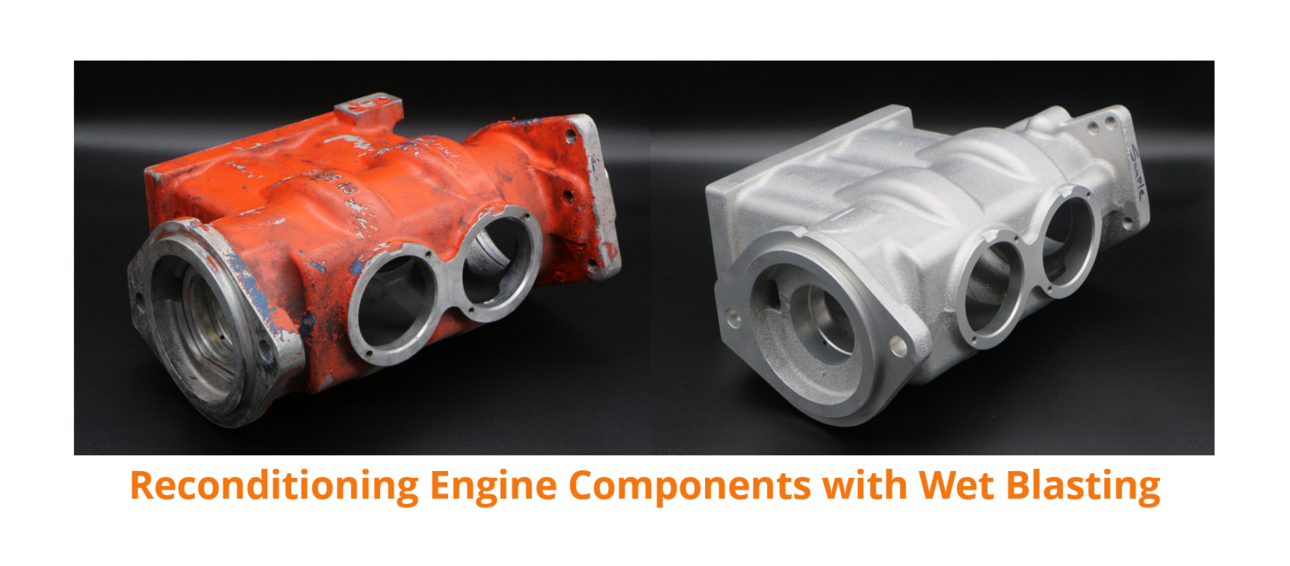
wet blasting technology, part 4 - typical wet blasting applications
, sramaker - Retour à l'aperçu
Wet blasting can do nearly any job that is done with dry shot blasting. The defining differences are that wet blasting does so more gently and without producing dust. In addition, wet blasting can handle a small amount of oil and grease unlike dry blasting.
At Rosler, we have more than 80 years’ experience in surface finishing. While wet blasting has gained popularity recently, we’ve used this technique to provide precise, repeatable results to a number of industries over the years.
Typical Applications
With proper testing and process parameters, wet blasting can achieve numerous surface finishing goals.
A fastener with heat discoloration before versus after wet blasting.
Depending on the work piece’s starting condition and successive finishing steps, rust, scale, oxidation, road grime, grease, and oil may need to be removed. Wet blasting can accomplish a variety of cleaning applications including:
- Dies and molds such as die castings and tire and glass molds.
- Automotive rebuilds such as engines, transmissions, brakes, etc.
- Investment castings such as boat propellers, pump impellers, housings, valve bodies, etc.
- Aircraft engine rebuilds.
- Various components before inspection or secondary processing.
Hydraulic components before and after wet blasting.
Work pieces with flashings and burrs must undergo deburring and deflashing. For example, firearm components require burr removal after drilling, milling, and turning. Drill bits and milling tools also require burr removal.
Despite the newest heat treatment processes, discoloration, oxidation, scale, and hard residues are found on cast and forged products as a result of manufacturing and environmental influences. Modern production methods, control and testing processes, and an uninterrupted continual processing of the cast and forged parts requires clean, light work piece surfaces.
Surface Texturing
Creating a somewhat rougher surface finish is a key step in preparation for painting, coating, and bonding with glue. Ensuring that subsequently applied coatings have a rough enough surface to adhere to improves the quality and life span of a work piece.
Examples of wet blasting applications for surface texturing include:
- Preparation of automotive parts for rubber coating such as brake and engine seals.
- Surface preparation to place a corrosion protection coating for screws.
- Surface preparation to place a primer on airplane components such as rotor blades, stringers, and wing spars.
- Orthopedic implants in which osseointegration and bone growth around the implant are encouraged. Light profiling of tibia plates, knee femorals, hip stems, and spinal implants helps promote this bone growth.
Stripping of Paint and Coatings
Wet blasting is ideal for stripping of paint and coatings from delicate work pieces. Processing of mineral-based construction materials such as concrete or sandstone, glass, textiles, and wood is possible with Rosler machines as well as the finishing of plastics and metals.
Wet blasting removes machining lines from aluminum gun bodies as shown in these before and after examples.
Wet blasting serves as an excellent method of applying a uniform, matte finish on work pieces. This finish can take various forms, including:
- Creating a pre-polish finish smoother than what can be achieved with dry blasting.
- Applying a non-glare, matte finish such as the finish required for surgical instruments.
- Masking machining lines on a variety of parts like tibia implants or aluminum gun bodies.
Landing gear includes many wet blasted components.
Shot peening is a process specially developed to improve the properties of components which are exposed to changing strains. For safety reasons, shot peening is also now absolutely necessary in the aviation and space industries. Shot peening is also essential in all industries requiring long lives for components including the automotive sector.
Wet blasting applications for shot peening are mainly used in conjunction with Almen strip N for glass beads, ceramic beads, and stainless steel shot.
Additive Manufacturing Post Processing
Additively manufactured components before and after wet blasting.
Wet blasting is an essential technology for various post processing tasks, specifically additive manufacturing. Wet blasting cleans the 3D printed components by removing residual powder and significantly reduces their initial high surface roughness. It is capable of de-powdering and providing general surface cleaning and initial surface smoothing from Ra = 1,000 micro inches down to Ra = 40-60 micro inches (25 µm to 1–1.5 µm).
On metal AM parts the loosely sintered grains on corners are effectively removed. The wet process eliminates the worry about residual powder containment or sparking during the blasting process.
De-contamination of nuclear power plant components
Manual wet blast cabinets allows for same removal of contaminants.
Removal of small, radioactive fragments from the component surface in nuclear power plants can also be achieved through wet blasting. The process decontaminates the components to a point where they can be declassified as radioactive. Special consideration regarding the water treatment are required to meet the requirements for this application.
The Rosler Way
With a trusted partner such as Rosler, you don’t need to worry about the ins and outs of an application. Contact us to discuss your wet blasting needs and challenges and we will deliver a solution. We’ll even demonstrate results with FREE sample processing in one of our global test centers. That’s the Rosler Way.
The complete Wet Blasting Technology Series includes:
- Part 1 – “Wet Blasting Gently Delivers Dramatic Finishing Results.”
- Part 2 – “Comparing Attributes, Advantages to Dry Blasting.”
- Part 3 – “Technical Features, Slurry Control Achieve Precise Finishing.”
- Part 4 – “Typical Wet Blasting Applications.”
- Part 5 – “PureFinish® Offers Food-Grade Excellence.”
Sign up for enews alerts to be notified of all Rosler blog posts!






